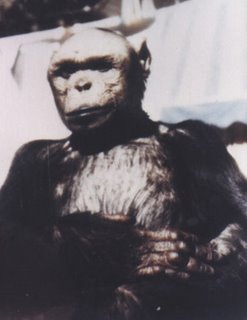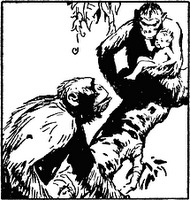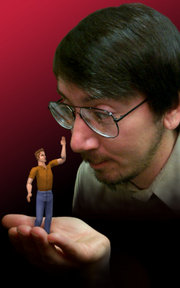
Earlier this year, our beloved leader decried “egregious abuses of medical research” like “human-animal hybrids” in his State of the Union speech. Haters were shocked at what sounded like science fiction nonsense and they mocked Bush for what they perceived as his loony ideas about science. But, as much as I also hate, I at least felt like I sorta knew what he was talking about, and it wasn’t that ridiculous. Fusing cells from different animals, even humans and animals, is not entirely new and wouldn’t surprise a developmental biologist.
After discussing this with an anthropologist friend of mine, I was alerted to a curious episode in science history in which researchers desperately hoped for the kind of human-animal mix haters thought George Bush was speaking against. This time, I was shocked. People actually tried to make an ape-human hybrid through breeding?! If you know me, you know I love a story that challenges traditional concepts of body integrity. And if you also can’t resist stories about chimps getting pumped full of human sperm, read on. This one’s a little long, but I think you’ll like the story.
Pretty much everything in this post, including all quotes, is based on a paper called Beyond Species: Il’ya Ivanov and His Experiments on Cross-Breeding Humans with Anthropoid Apes by Kirill Rossiianov of the Russian Academy of Sciences. The paper was published in 2002, but was new to me this year. The whole 35-page thing is worth checking out, but since it is not online, and I don’t want it to drop out of my memory, I’m going to outline it here.
Il’ya Ivalov was a pioneer of artificial insemination in pre-Soviet Russia. Prior to the early 1900s, artificial insemination was something of a laboratory curiosity. The sex act was believed to have an important function apart from gettin’ the gametes together: “’natural’ sexual intercourse … was thought to be crucial for successful impregnation as well as for the health of offspring.”
Yet Ivanov saw in artificial insemination the possibility for “mass improvement” of animal stocks. In his modernizing view, artificial insemination could be used to control and guide breeding of horses, sheep, and other farm animals. During the period in which Ivanov was perfecting his insemination techniques, he benefited from the pre-revolutionary attempts to reform and improve Russian agriculture. Ivanov’s lab became more experimental, and even nurtured Yuriy Filipchenko and his genetics experiments, the first ever in Russia.
As Ivanov began to explore fundamental problems in biology, he began to consider using artificial insemination to cross species. “Artificial insemination … was, for Ivanov, the experimental tool for constructing new forms of life, forms that did not exist in nature.” He crossed different species of birds and made a zorse (or zebroid), a zebra-horse hybrid. And in 1910 he “mentioned for the first time the possibility of inseminating a female ape with human sperm.”
Directly after the Bolshevik revolution, Ivanov’s research program fell on hard times. The upheavals of the revolution destroyed the patronage system Ivanov had relied on for funds. Yet aspects of Ivanov’s research appealed to the Bolsheviks. As the Soviet system began to take form, Ivanov found new support. A representative of the Commissariat of Enlightenment thought the possibility of making human-ape hybrids was an “exclusively important problem for Materialism.” Someone from the Commissariat of Agriculture thought such hybrids “should become a decisive blow to the religious teachings, and may be aptly used in our propaganda and in our struggle for the liberation of working people from the power of the Church.”
In the scientific and technological idealism of the early Soviet era, Darwinism was seen as an effective tool to destroy religious superstitions. A man-ape hybrid would have been considered proof of the fundamental biological similarity of man and ape, and thus an evolutionary relationship would be strongly supported. Such a hybrid, Ivanov said, “may provide extraordinarily interesting evidence for a better understanding of the origin of man.”
By the mid 1920s, Ivanov had received a government grant to travel to Africa and conduct hybridization experiments. An initial trip in March 1926 was a failure; the only chimps Ivanov was able to get access to at a primate research station in French Guinea (Guinea today) were all prepubescent. Ivanov made a second trip in November. Over the next few months, he was able to capture adult chimpanzees. In February 1927, he and his 22-year-old son undertook their first insemination, injecting human sperm into the vaginas of two female chimps. In June, another insemination was performed.
All three inseminations failed. Ivanov used two sperm samples from local men, and he examined the sperm to make sure there were motile cells. The failure, he knew, was to be expected: to have a real chance at success he would need a greater sample size than three. However, the troubles he had inseminating just three chimps—some animals got sick and died in captivity—convinced Ivanov to flip the experiment on its head. It was much easier, he thought, to gather sperm from a few apes and use it to inseminate many human females. Ivanov worked his contacts in Africa in attempts to find doctors willing to secretly subject their female patients to such experiments. Despite some initial agreements, the whimsies of colonial government eventually sided against Ivanov, and, as far as scholars can tell, he never conducted inseminations with human females in Africa.
Back in the Soviet Union, the Academy of Sciences, an organization that had originally supported Ivanov’s work, “expressed abhorrence and indignation once the academicians realized that Ivanov had been trying to inseminate women in Africa without [the women’s] consent.” The Academy withdrew support, so Ivanov hooked up with the more radical Communist Academy and an associated group called the Society of Materialist Biologists. The Materialist Biologists forged a “Marxist approach in biology” that included “a predisposition towards scientific control of life and active human interference into biological evolution.” Ideas of radical family restructuring were also swirling, with ideologues hyping artificial insemination as a way of controlling human reproduction (“Inculcation of the idea that not simply the sperm of a ‘beloved person’ should be used for the conception of a baby, but that this sperm should be obtained from a certain recommended source…”)
In this atmosphere, and with the support of these groups, Ivanov began planning new insemination experiments. He had brought apes back with him from Africa and established the first primate research center in the Soviet Union, so he had the sperm. All he needed were the women, those “whose interest would be of idealistic … and not of monetary nature.”
By 1928, Ivanov was planning on using sperm from an orangutan that had been imported to the research center and he found at least one volunteer, a woman called G., from Leningrad, who wrote, “Dear Professor, … With my private life in ruins, I don’t see any sense in my further existence … But when I think that I could do a service for science, I feel enough courage to contact you. I beg you, don’t refuse me … I ask you to accept me for the experiment.” But the experiment was postponed after the orang died.
Meanwhile, as the effects of the same cultural revolution that spawned the Materialist Biologists grew out of control, Ivanov became isolated as a member of the “’old’ specialists then in danger of being subjected to political criticism and repression.” Ivanov began to be criticized in public by men angling for influence in the organizations in which Ivanov was a member. And by the end of 1930, Ivanov was arrested, “convicted of having created a counterrevolutionary organization among agricultural specialists,” and exiled to the Kazakh Republic. He had his civil status restored in 1932, but two years in exile had taken a toll on his health. He died on March 20, 1932, one day before he was to return to Moscow.
As far as scholars can tell, Ivanov was never able to impregnate a woman using ape sperm. Personally, I have always assumed a human-ape hybrid was impossible due to the fact that, despite great general similarities between human and chimp DNA, humans have 23 pairs of chromosomes while apes have 24. Yet the dream has lingered into the modern genetic age. In the 1970s, a chimpanzee called Oliver was suspected of being a hybrid due to his odd appearance and habit of walking upright, although genetic tests in the 1990s determined he was a full-blood chimpanzee. And in 1971, Geoffrey Bourne, director of the Yerkes Primate Center in Atlanta, wrote, “There seems to be very little physiological reason why artificial insemination could not be used between man and the apes with a possibility that a viable child might be reproduced … And it is surprising that this type of hybridization has in not, in fact, already taken place.”
Finally, research from earlier this year suggests that as human and chimpanzee ancestors were diverging around six million years ago, hybridization continued, altering the genome in ways that are detectable today. Maybe it is still possible? Bush wouldn’t like it. I might, but what an ethical/moral/philosophical mess it would create. Man or animal? Or … MANIMAL?!!!!
CONTINUE READING...
Collapse post






